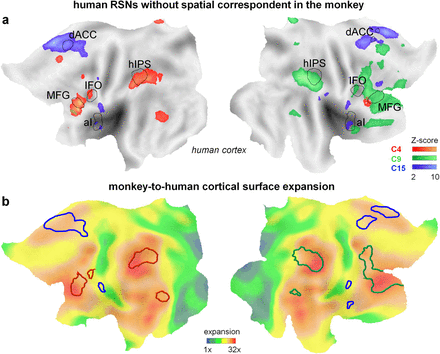Our ancestors evolutionarily split from those of rhesus monkeys about 25 million years ago. Since then, brain areas have been added, have disappeared or have changed in function. This raises the question, ‘Has evolution given humans unique brain structures?’.
Scientists have entertained the idea before but conclusive evidence was lacking. By combining different research methods, we now have a first piece of evidence that could prove that humans have unique cortical brain networks.
Professor Vanduffel explains: “We did functional brain scans in humans and rhesus monkeys at rest and while watching a movie to compare both the place and the function of cortical brain networks. Even at rest, the brain is very active. Different brain areas that are active simultaneously during rest form so-called ‘resting state’ networks. For the most part, these resting state networks in humans and monkeys are surprisingly similar, but we found two networks unique to humans and one unique network in the monkey.”

Figure B: Image from parent study, on which is shown how the cerebral cortex of the human being through the evolution grew and developed areas that are specific for the human being. Credited to Wim Vanduffel.
“When watching a movie, the cortex processes an enormous amount of visual and auditory information. The human-specific resting state networks react to this stimulation in a totally different way than any part of the monkey brain. This means that they also have a different function than any of the resting state networks found in the monkey. In other words, brain structures that are unique in humans are anatomically absent in the monkey and there no other brain structures in the monkey that have an analogous function. Our unique brain areas are primarily located high at the back and at the front of the cortex and are probably related to specific human cognitive abilities, such as human-specific intelligence.”
The study used fMRI (functional Magnetic Resonance Imaging) scans to visualise brain activity. fMRI scans map functional activity in the brain by detecting changes in blood flow. The oxygen content and the amount of blood in a given brain area vary according to a particular task, thus allowing activity to be tracked.
The research is available via the Journal of Neuroscience.
Notes about this evolutionary neuroscience research
Contact: Wim Vanduffel – KU Leuven
Source: KU Leuven press release
Image Source: Image adapted from KU Leuven press release and is credited to Wim Vanduffel.
Original Research: Abstract for “Evolutionarily Novel Functional Networks in the Human Brain?” by Dante Mantini, Maurizio Corbetta, Gian Luca Romani, Guy A. Orban and Wim Vanduffel in Journal of Neuroscience. Published online February 20 2013 doi: 10.1523/JNEUROSCI.4392-12.2013







